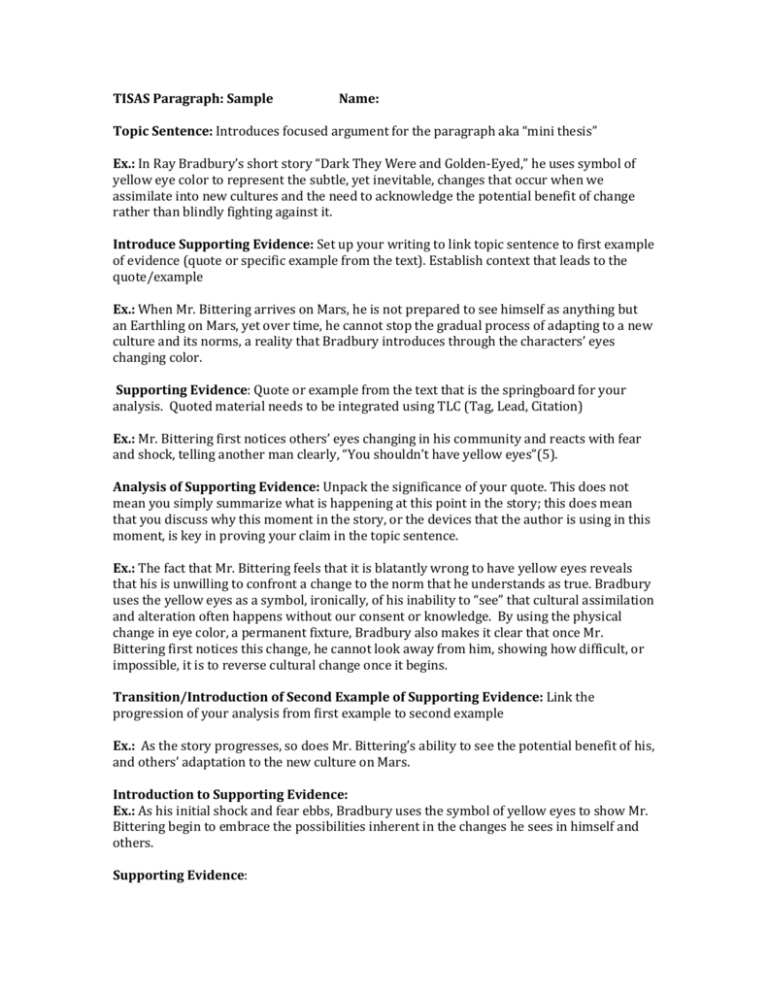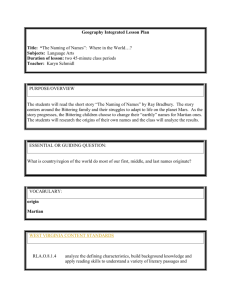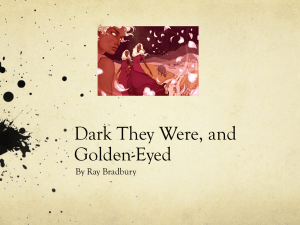Sample TISAS Paragraph 9th
advertisement

TISAS Paragraph: Sample Name: Topic Sentence: Introduces focused argument for the paragraph aka “mini thesis” Ex.: In Ray Bradbury’s short story “Dark They Were and Golden-Eyed,” he uses symbol of yellow eye color to represent the subtle, yet inevitable, changes that occur when we assimilate into new cultures and the need to acknowledge the potential benefit of change rather than blindly fighting against it. Introduce Supporting Evidence: Set up your writing to link topic sentence to first example of evidence (quote or specific example from the text). Establish context that leads to the quote/example Ex.: When Mr. Bittering arrives on Mars, he is not prepared to see himself as anything but an Earthling on Mars, yet over time, he cannot stop the gradual process of adapting to a new culture and its norms, a reality that Bradbury introduces through the characters’ eyes changing color. Supporting Evidence: Quote or example from the text that is the springboard for your analysis. Quoted material needs to be integrated using TLC (Tag, Lead, Citation) Ex.: Mr. Bittering first notices others’ eyes changing in his community and reacts with fear and shock, telling another man clearly, “You shouldn’t have yellow eyes”(5). Analysis of Supporting Evidence: Unpack the significance of your quote. This does not mean you simply summarize what is happening at this point in the story; this does mean that you discuss why this moment in the story, or the devices that the author is using in this moment, is key in proving your claim in the topic sentence. Ex.: The fact that Mr. Bittering feels that it is blatantly wrong to have yellow eyes reveals that his is unwilling to confront a change to the norm that he understands as true. Bradbury uses the yellow eyes as a symbol, ironically, of his inability to “see” that cultural assimilation and alteration often happens without our consent or knowledge. By using the physical change in eye color, a permanent fixture, Bradbury also makes it clear that once Mr. Bittering first notices this change, he cannot look away from him, showing how difficult, or impossible, it is to reverse cultural change once it begins. Transition/Introduction of Second Example of Supporting Evidence: Link the progression of your analysis from first example to second example Ex.: As the story progresses, so does Mr. Bittering’s ability to see the potential benefit of his, and others’ adaptation to the new culture on Mars. Introduction to Supporting Evidence: Ex.: As his initial shock and fear ebbs, Bradbury uses the symbol of yellow eyes to show Mr. Bittering begin to embrace the possibilities inherent in the changes he sees in himself and others. Supporting Evidence: Ex.: When Mr. Bittering swims with his family in the canal, he and his wife discuss the changes rendered in their family. Referencing their children’s’ changed eye color, Mr. Bittering muses that, “Maybe we’re children too. At least to Mars”(7). Analysis of Supporting Evidence: Rather than respond with bitterness in the face of this change, Mr. Bittering now see the potential for rebirth or growth in this new culture. In the past he raged against this change, relying blinding on what he knew to be “true” from his past. Now, his eyes, and his mind, have opened to what it could mean to be a “child of Mars,” and he is ready to use his growth to impact his culture. Concluding Sentence: This sentence ties the two different levels of analysis in your paragraph together. Each example of evidence and its corresponding analysis should build upon the first to sustain the full argument, so you need to tie them together at the end. Ex.: Bradbury argues that while the process of assimilation is often gradual, we must open our eyes to look for its signs, and analyze the risks and benefits of cultural assimilation. Put it all Together: In Ray Bradbury’s short story “Dark They Were and Golden-Eyed,” he uses symbol of yellow eye color to represent the subtle, yet inevitable, changes that occur when we assimilate into new cultures and the need to acknowledge the potential benefit of change rather than blindly fighting against it. When Mr. Bittering arrives on Mars, he is not prepared to see himself as anything but and Earthling on Mars, yet over time, he cannot stop the gradual process of adapting to a new culture and its norms, a reality that Bradbury introduces through the characters’ eyes changing color. Mr. Bittering first notices others’ eyes changing in his community and reacts with fear and shock, telling another man clearly, “You shouldn’t have yellow eyes”(5). The fact that Mr. Bittering feels that it is blatantly wrong to have yellow eyes reveals that his is unwilling to confront a change to the norm that he understands as true. Bradbury uses the yellow eyes as a symbol, ironically, of his inability to “see” that cultural assimilation and alteration often happens without our consent or knowledge. By using the physical change in eye color, a permanent fixture, Bradbury also makes it clear that once Mr. Bittering first notices this change, he cannot look away from him, showing how difficult, or impossible, it is to reverse cultural change once it begins. As the story progresses, so does Mr. Bittering’s ability to see the potential benefit of his, and others’ adaptation to the new culture on Mars. As his initial shock and fear ebbs, Bradbury uses the symbol of yellow eyes to show Mr. Bittering begin to embrace the possibilities inherent in the changes he sees in himself and others. When Mr. Bittering swims with his family in the canal, he and his wife discuss the changes rendered in their family. Referencing their children’s’ changed eye color, Mr. Bittering muses that, “Maybe we’re children too. At least to Mars”(7). Rather than respond with bitterness in the face of this change, Mr. Bittering now see the potential for rebirth or growth in this new culture. In the past he raged against this change, relying blinding on what he knew to be “true” from his past. Now, his eyes, and his mind, have opened to what it could mean to be a “child of Mars,” and he is ready to use his growth to impact his culture. Bradbury argues that while the process of assimilation is often gradual, we must open our eyes to look for its signs, and analyze the risks and benefits of cultural assimilation. TISAS Paragraph: Topic Sentence: Introduces focused argument for the paragraph aka “mini thesis” Introduce Supporting Evidence: Set up your writing to link topic sentence to first example of evidence (quote or specific example from the text). Establish context that leads to the quote/example Supporting Evidence: Quote or example from the text that is the springboard for your analysis. Quoted material needs to be integrated using TLC (Tag, Lead, Citation) Analysis of Supporting Evidence: Unpack the significance of your quote. This does not mean you simply summarize what is happening at this point in the story; this does mean that you discuss why this moment in the story, or the devices that the author is using in this moment, is key in proving your claim in the topic sentence. This should be at least 2-3 sentences in length. Transition/Introduction of Second Example of Supporting Evidence: Link the progression of your analysis from first example to second example Introduction to Supporting Evidence: Supporting Evidence: Analysis of Supporting Evidence Concluding Sentence: This sentence ties the two different levels of analysis in your paragraph together. Each example of evidence and its corresponding analysis should build upon the first to sustain the full argument, so you need to tie them together at the end.











